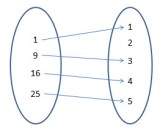Ordered Pair
Two elements listed in a specific order, form an ordered pair, denoted by
.
In an ordered pair , we call a as the first component and b as the second component.
By changing the positions of the components, the ordered pair is changed, i.e.
Also if
Thus
Cartesian Product of Two Sets
Let be two non-empty sets. Then their Cartesian product
is the set of all ordered pairs
such that
Example 1:
Let
Then
Relation
Let be two non-empty sets. Then every subset of
is called a relation from
. i.e., if
, then
is a relation from
Representation of a Relation
Roster Form: When a relation is represented by the set of all ordered pairs contained in it, then it is said to be in roster form.
Example 2:
If then a relation
defined as ‘is the square of’ can be represented in the roster form as:
You will notice that the first component of each subset is square of the second component of the subset.

Arrow Diagram: Let be a relation from
. We can draw the sets as shown pictorially. Then, we draw arrows from
to indicate the pairing of the corresponding elements related to each other. Thus, we can show the relation given in Example 2 by the arrow diagram as shown.
Set Builder Form: A relation from
is said to be in a Set-Builder form when written as:
The relation given in Example 2 can be represented in the set-builder form as:
Domain and Range of a Relation
Let be a relation from
. Then,
Domain ( ) = Set of first components of all ordered pairs in
Range ( ) = Set of second components of all ordered pairs in
Rule of Relation
The property that tells us how the first component is related to the second component of each ordered pair in , is called the rule of the relation.
Let’s look at the following example:
Example 3:
Let
Let be the relation ‘is less than’ from
. Find
. Also, write down the domain and range of
.
Solution:
We have:
Note: We take only those pairs in which
Hence,
Domain ( ) = Set of first components of elements of
Range ( ) = Set of second components of elements of
